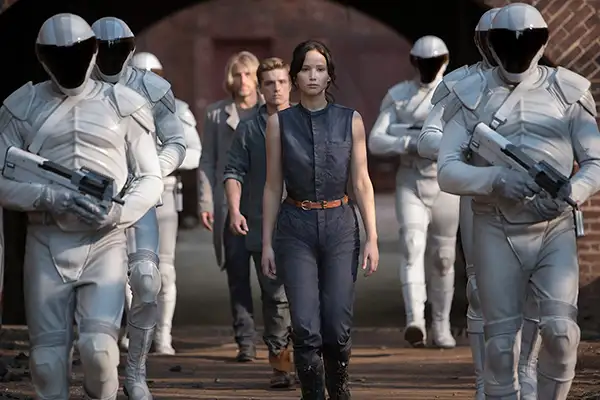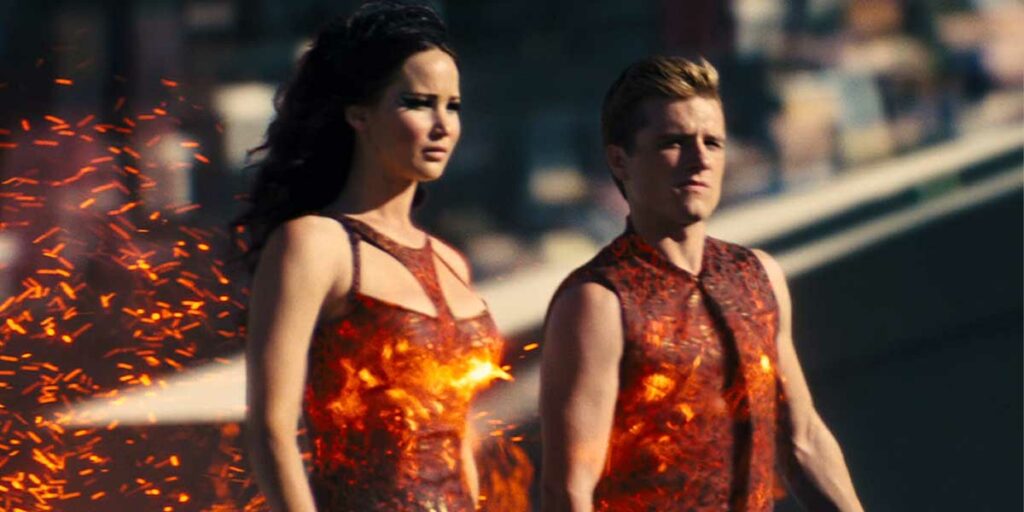Catching Fire, the second instalment of the Hunger Games series, is easily the best film in the entire saga: here is why.
Ten years ago, Catching Fire came out in theatres worldwide, following the success of The Hunger Games, the first instalment of the saga, the year before. Even ten years later, Catching Fire remains the best film in the entire Hunger Games saga, made up of four films in total. While many fans would agree that the second movie is the best one, I have often wondered what exactly made it such a great film in an already strong and established saga. As the Hunger Games is about to come back to our screens with a prequel film, The Ballard of Songbirds and Snakes, what better time to analyse the strengths of this movie?
Catching Fire follows up on the events of the first film of the series, The Hunger Games: after winning their games, Katniss (Jennifer Lawrence) and Peeta (Josh Hutcherson) embark on their victory tour, in which they will have to convince the people of Panem, and President Snow (Donald Sutherland), of their love in order to quell the spark of rebellion their joint victory has ignited in the districts. In an effort to stop a revolution, President Snow announces that for the 75th Hunger Games, the tributes will be chosen amongst the victors. Therefore, Katniss and Peeta are once again back in the arena but, this time, the games will be much different, as they find themselves competing with other victors, such as Finnick (Sam Claflin) and Johanna (Jena Malone).
Compared to The Hunger Games, Catching Fire has to do little to no worldbuilding. Most of the dystopic setting of the Hunger Games saga is established in the first film where the audience is introduced to the concept of the yearly games where 24 kids are chosen to kill each other for the Capitol’s entertainment. As this context applies to this movie as well, the second film of the series can jump straight into the action and conflict. This makes for a much more compelling watch with a faster pace that immediately goes to the core of the story. Moreover, as the Hunger Games world is so rich and complex, there is still a lot the audience still has to discover in the second instalment of the saga.
In fact, this also allows Catching Fire to explore Capitol City and its citizens more. In the first film, we only see a glimpse of what life in the Capitol really looks like, and in the following films, the focus moves away from the extravagant lifestyle of the Capitol. Therefore, the second movie is the only chance to truly explore this as Katniss and Peeta experience the lavish parties held in their honour. The contrast with life in the district is immediately evident both to the main characters and to the viewers: while people in the districts starve and live in poverty, people in the Capitol enjoy an abundance of resources the poorest districts could only dream of.

In the second film of the saga, we can also delve deeper into the complexities of the games, a structure created to systematically control its winners even after everything they have been through during the games. Catching Fire opens a window into the life of victors, which was hinted at in The Hunger Games in the character of Haymitch (Woody Harrelson). After winning the games, Katniss suffers from a significant amount of trauma and PTSD: while she may not be in the arena anymore, the actual games are far from over. Now, she is even more subjected to the control of the Capitol: from her physical appearance to her marriage, everything has to be crafted in order to appease President Snow.
President Snow is established even more as a villain in the second film: his presence in the first film is elusive and distant, but in this one, he directly opposes Katniss, thus establishing himself as the main antagonist in the series. In this sense, Catching Fire also looks at the future of the saga with multiple hints at an upcoming rebellion and a war that could involve all the districts. Most interestingly, throughout the second half of the film, there is a feeling of mystery to be uncovered, as if there was a bigger scheme neither we nor the characters are aware of, one that will only be unveiled in the following instalments of the series.
The film also introduced director Francis Lawrence to the world of Hunger Games. Although he did not direct the first film, there would be no Hunger Games saga without Francis Lawrence, as he quickly became almost synonymous with the entire series after directing and bringing his unique touch to the remaining three films of the franchise. Similarly, various significant characters are introduced in Catching Fire which will play a significant role in the rest of the series, namely Finnick who soon became a fan favourite despite not being present in the first film. With these new characters, the second film manages to explore the world of Panem much further than the confines of the arena or District 12.
The final scene of the second film also creates a fantastic cliffhanger for the rest of the series and establishes the end of the Hunger Games saga as we have known it so far: there is a clear feeling that after the events of this film, everything is about to change. Catching Fire is Hunger Games at its very best as it delivers a successful sequel, further expanding the universe the Hunger Games saga is set in with a strong ensemble cast that will be at the core of the following movies. All of this is something fans of the saga can hope to see again in the upcoming The Ballard of Songbirds and Snakes which, just like Catching Fire, will also be directed by Francis Lawrence.
Catching Fire is now available to watch on digital and on demand.

